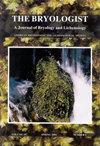欧洲苔藓科的一个主要新处理方法
IF 1.5
4区 生物学
Q4 PLANT SCIENCES
引用次数: 1
摘要
苔藓科是最大的苔藓科之一,与Dicranaceae、Orthotriceae和Pottiaceae并列。长期以来,它一直以难以进行物种鉴定而闻名,尤其是在大型复杂的Ptychomomum属中。苔藓科分布在世界各地,除了茂密的森林和热带低地之外,大多数栖息地都有很好的代表性。它们通常占当地和区域植物群多样性的10%,因此,尽管存在严重的识别问题,但在植物区系和生物多样性研究中无法轻易避免。对家庭进行新的全面治疗总是一件好事,因为世界上大多数地区的治疗方法都很少。大卫·T·霍利亚克(David T.Holyoak)的这本关于苔藓科的新书讲述了古北极西部的苔藓科,主要是俄罗斯联邦西部的欧洲,包括Macaronesia。植物群处理的东部界限包括乌克兰、白俄罗斯、爱沙尼亚、拉脱维亚和立陶宛的部分地区。在东南部,土耳其的部分地区也包括在内。相邻区域的事件也包括在内。这本精装书制作得很吸引人,封面上有一张漂亮的照片,上面是帕伦斯灰蝶的粉红色光辉。它分为几个部分,包括介绍材料、几套二分键以及一个多访问键、物种账户、几个附录、一个词汇表和一个所有名称的索引,包括同义词的完整列表。在准备这篇评论时,我广泛地使用了这本书,它很好地经受住了反复使用。这篇文章写得很干净,几乎没有错别字。介绍材料包括一个关于分类的简短部分,包括对我在《北美苔藓植物区系》(Spence 2014)中使用的基于形态学的分类的常见负面评论。这些评论似乎是强制性的,因为欧洲作者在最近关于家庭的论文中重复了这些评论。它们有一些有效性,但也对我的工作有很大的困惑和误解。然而,这里不是讨论这些问题的地方;我将在其他地方介绍它们。介绍部分还包括关于物种排列和处理的说明,一个关于特征和提示的有用部分,用于识别目的,以及几个关键。共处理了5属69种:Anomobrum、Bryum、Imbribrum、Ptychostomum和Rhodobrum。书写良好且清晰的识别钥匙对家族中的物种识别至关重要。Holyoak包括一个通用密钥,该密钥导致六个额外的密钥,包括一个用于具有成熟孢子体的物种的密钥,三个用于具有根状块茎、叶腋球芽和丝状宝石的物种的钥匙,以及一个用于缺乏这些结构的不育集合的密钥。第六把钥匙是一把基于表格形式的10个字符的多路钥匙。我试过各种标本的钥匙,总体来说效果很好,尽管我承认我没有试过无菌标本的钥匙。这把钥匙是鉴定无菌标本的最后一搏,这总是有问题的。正如塞恩斯伯里在他的《新西兰植物志》(Sainsbury 1955:第265页)中所指出的,“粗糙和不完美的材料很少有价值本文章由计算机程序翻译,如有差异,请以英文原文为准。
A major new treatment to the Bryaceae of Europe
The Bryaceae is one of the largest moss families, along with the Dicranaceae, Orthotrichaceae and Pottiaceae. It has long had a reputation for difficulty in species identification, especially in the large and complex genus Ptychostomum. The Bryaceae are distributed worldwide and are well represented in most habitats other than dense forests and the lowland tropics. They often represent up to 10% of the diversity in local and regional floras, and thus cannot easily be avoided in floristic and biodiversity studies despite serious identification issues. It is always a good thing to have a new comprehensive treatment of the family, as there are so few available for most parts of the world. This new book on the Bryaceae by David T. Holyoak treats the family in the western Palearctic, essentially Europe west of the Russian Federation, and including Macaronesia. The eastern limits of the flora treatment include portions of Ukraine, Belorussia, Estonia, Latvia and Lithuania. To the southeast, portions of Turkey are also included. Occurrences from adjacent areas are also included. The hardback book is attractively produced, with a nice cover photo of Ptychostomum pallens in all its pink glory. It is organized into several sections, including the introductory material, several sets of dichotomous keys as well as a multi-access key, species accounts, several appendices, a glossary and an index to all names including full lists of synonyms. I have used the book extensively while preparing this review and it has held up well to repeated use. The text is quite clean, with very few typos. The introductory material includes a short section on classification, including the usual negative comments on my morphologically based classification used in the Bryophyte Flora of North America (Spence 2014). These comments seem to be obligatory as they are repeated in most recent papers on the family by European authors. There is some validity to them, but also significant confusion and misunderstanding of my work. However, this is not the place to discuss these issues; I will present them elsewhere. The introductory sections also include notes on the arrangement and treatment of species, a useful section on characters and hints for identification purposes, and several keys. In all, 69 species are treated in five genera: Anomobryum, Bryum, Imbribryum, Ptychostomum and Rhodobryum. Well-written and clear identification keys are critical to species identification in the family. Holyoak includes a general key that leads to six additional keys, including one to species with mature sporophytes, three keys for species with rhizoidal tubers, leaf axil bulbils, and filamentous gemmae, and a key for sterile collections lacking these structures. The sixth key is a multi-access one based on 10 characters in tabular form. I have tried the keys with various specimens and in general they work well, although I confess that I have not tried the key to sterile specimens. This key is included as a last-ditch attempt to identify sterile specimens, which is always problematic. As Sainsbury noted in his New Zealand flora (Sainsbury 1955: p. 265), ‘‘Scanty and imperfect material is seldom worth
求助全文
通过发布文献求助,成功后即可免费获取论文全文。
去求助
来源期刊

Bryologist
生物-植物科学
CiteScore
2.40
自引率
11.10%
发文量
40
审稿时长
>12 weeks
期刊介绍:
The Bryologist is an international journal devoted to all aspects of bryology and lichenology, and we welcome reviews, research papers and short communications from all members of American Bryological and Lichenological Society (ABLS). We also publish lists of current literature, book reviews and news items about members and event. All back issues of the journal are maintained electronically. The first issue of The Bryologist was published in 1898, with the formation of the Society.
Author instructions are available from the journal website and the manuscript submission site, each of which is listed at the ABLS.org website.
All submissions to the journal are subject to at least two peer reviews, and both the reviews and the identities of reviewers are treated confidentially. Reviewers are asked to acknowledge possible conflicts of interest and to provide strictly objective assessments of the suitability and scholarly merit of the submissions under review.
 求助内容:
求助内容: 应助结果提醒方式:
应助结果提醒方式:


